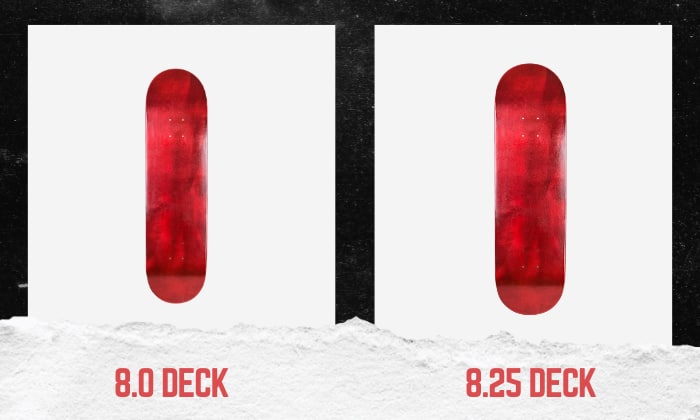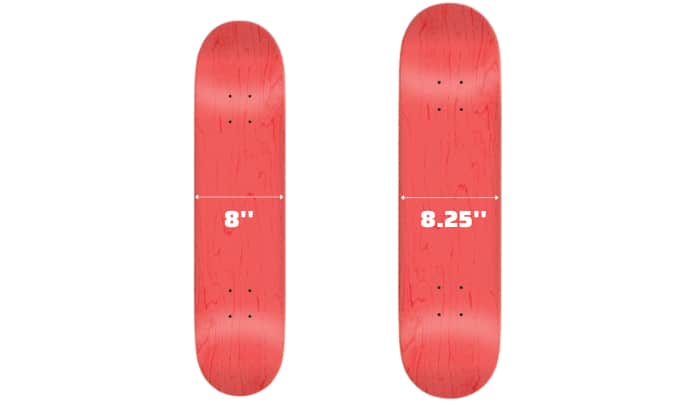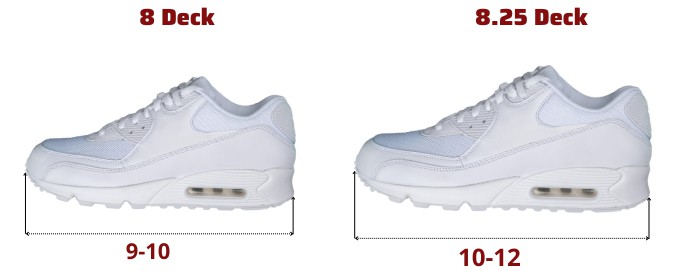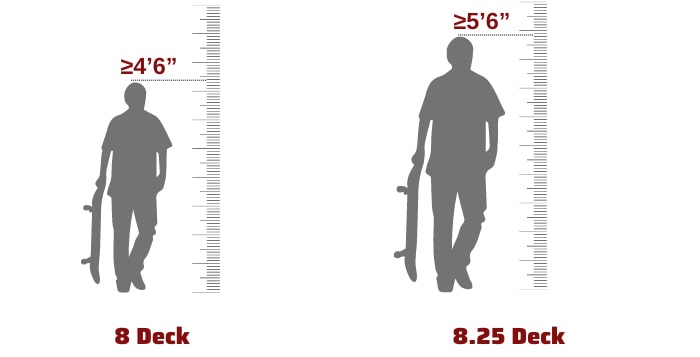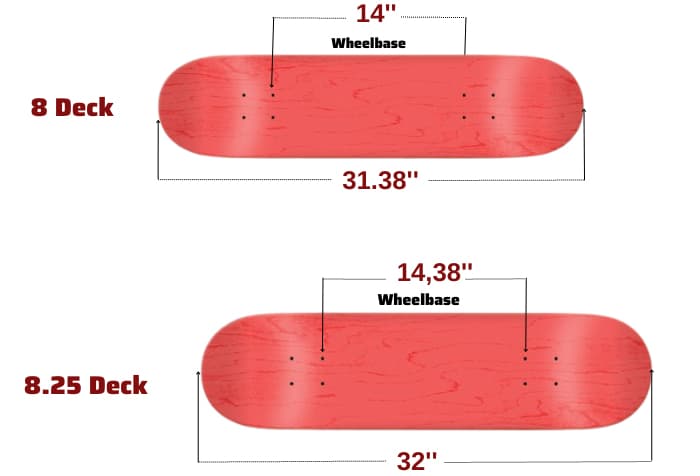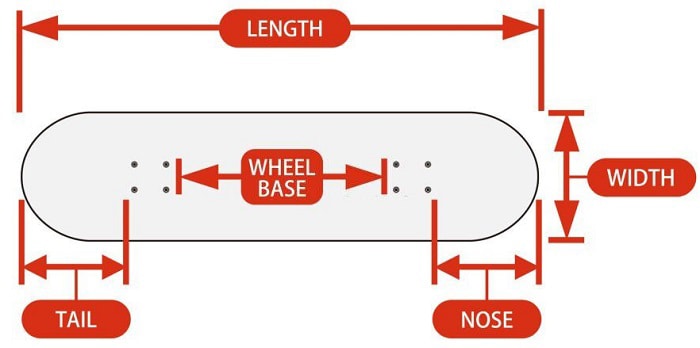The sizes indicated on skateboards displayed in online and physical shops aren’t only a reminder of skill levels and age. More often, they signify what purpose the board suit best, be it for performing tricks or simply cruising.
Let’s take the 8.0 VS 8.25 deck, for example. Although the one-fourth inch difference may seem negligible, this deviation actually has a big impact on our rides.
So, in this article, we will explore why manufacturers built skateboards varying by only a quarter inch. Also, we will discover what an 8.0 and 8.25 skateboard size can do on the streets or parks.
Table of Contents
8.0 and 8.25 Skateboard Decks: Explained
In short, 8.0 and 8.25 refer to the skateboard deck width, which commonly falls within the range of 7.0 to 9.0. Let’s explore the specifics below.
8.0 decks
8.0 skateboard decks mean that they have a width of 8 inches. So if you’re to calculate 8.0 skateboard in cm, that would be 20.32 centimeters.
A board this size would suit skates with US shoe sizes 9 to 10. It’s most suitable for skating in the streets, parks, and transition terrain.
8.25 decks
Similarly, 8.25 skateboard dimensions have a width of 8.25 inches—0.25 inch wider than their 8.0 counterpart. With that increase in size, these decks cater to people with US shoe sizes of 10 to 12.
Like the 8″ skateboard decks, this 8.25 variant also works best for technical skateboarding in the streets, parks, and transition terrains.
8.0 and 8.25 Skateboard Size Comparison
Different performance aspects compose skateboarding as a sport. And in these areas, 8.0 and 8.25 boards almost seem similar. Some could be subjective, but let’s amplify their differences.
1. Convenience
Discussions among skaters arguing about 8.0 and 8.25 boards garnered relevant comments.
Some people claim that 8.25 skateboard decks are better for landing when performing tricks because of their broader stepping surface. Additionally, the size increment makes the skateboard more stable when riding around.
While 8 inch skateboard decks are smaller, such a difference makes them easier to lift when doing tricks. Besides that, given that skaters often carry them around, the 1/4-inch size reduction makes the board easier to bring.
2. Recommended shoe size
Essentially, an 8.25 inch skateboard deck suits skaters with larger feet. So those with US shoe sizes 10 to 12 would likely find such boards a good fit.
On the other hand, a set of shoes slightly over 8″ will likely fit an 8 inch skate deck. If you’re to translate this to US shoe size, it’d be around 9 to 10.
Note that the recommendations above are based on the fact that the ideal deck width means your feet should slightly stick out from the board.
3. Skater height
At what height do 8.0 and 8.25 skateboards fit? Is this aspect proportionate to the skateboard deck’s height?
To a certain degree – yes. In short, 8.0 decks are more versatile, being suitable for people with a height of 4’6” and up. Meanwhile, 8.25 decks are slightly more limited, as only those 5’6” or taller are recommended to use them.
4. Board length and wheelbase
As the skateboard’s width increases, so will its deck length and wheelbase. An 8.0 deck will typically have a length of 31.38 inches and a 14-inch wheelbase. If you upgrade to an 8.25 deck, it should be 32 inches long, and the distance between the front and rear wheels will be around 14.38 inches.
Although the board length generally doesn’t greatly impact your skating experience, the wheelbase has a big say in the skateboard’s speed and stability. The bigger the wheelbase, the more stable the skateboard will be – at the expense of speed.
The takeaway here is: 8.0 decks, with their smaller wheelbase, should be faster than their 8.25 counterparts, but not as stable.
5. Truck size
Lastly, the difference in deck width may also result in varied truck sizes, depending on what brand you’re using. Given how brands label and size their trucks differently, you’ll have to rely on each brand guide to know what specific truck you need for your skateboards.
For example, if you’re going for ACE skateboard trucks, then the 8.25 skateboard truck size is model 44 or 33, whereas 8.0 decks can only use the latter model. For those using Venture products, 5.2 and 5.6 trucks are required for 8.0 and 8.25, respectively.
Pros and Cons
As mentioned, even a quarter-inch difference in deck size matters. It’s time to highlight the advantages and downsides of 8.0 and 8.25 skateboards.
8.0
- Ideal for freestyle skating or any trick needing light decks
- Perfect for smaller, shorter skaters
- More versatile in rider height
- Can travel faster than 8.25 decks
- Not as stable as 8.25 decks
8.25
- Better for landing tricks
- One of the best picks for taller riders
- Offer more stability while riding
- Not as fast as 8.0 decks
Which is Better for Beginners
Between an 8.0 and 8.25 deck width, which one suits this skater level better?
A noteworthy advantage of the 8.25 skateboard in this aspect is its added stepping surface. It may not be significant, but it's better than a narrower board. The increased stability should also make it easier for beginners to keep balance.
Skateboards at 8.0 can also be ideal for beginners. However, these skaters need enough balance training to work with narrower decks.
Related: 8 Vs 8.5 Skateboard
Tips for Choosing the Right Size
What size skateboard deck should I get? It's easy to feel astonished by the graphics and styles of skateboards displayed in the store. But is that all that matters? No. Llet's take a few tips to choose the perfect deck size.
- How long is a 8.25 skateboard? As mentioned above, it’s 32 inches long. Again, the length will not impact your skating experience much—it’s the wheelbase that does. To jog your memory, a bigger wheelbase will be more stable, although the skating speed will also be slower.
- Your shoe size matters. As pointed out, the tips of the shoes should slightly go beyond the deck's edges when you're in a skating position – that's when your feet are almost parallel to the board's length.
- Deck and shoe size go along with preference. Nothing beats a selection combined with comfort and optimum board feel. Sometimes, the numbers might not give us the best skateboard control. So, test each board you plan to choose.
Conclusion
Like color shades, the minimal differences in skateboard sizes yield noticeable changes. Some say they're negligible, but such is not until misfortunes or breakthroughs happen on their rides. Hence, it's appropriate that we pay attention to these details.
Between an 8.0 VS 8.25 deck, several factors distinguish them, such as their recommended skater heights, shoe size, wheelbase, and several other factors.
Ultimately, each skateboard deck size has its own merit and drawback. It's up to you which to take.

Hi, I am Charles Harris. I opened this site to write as much as I can about my biggest passion – skateboarding!
I started as a clumsy yet passionate rookie 10 years ago to now a still passionate yet much better skateboarder! But I have to tell you, the whole journey has always been fun and rewarding, indeed not without hardship.


